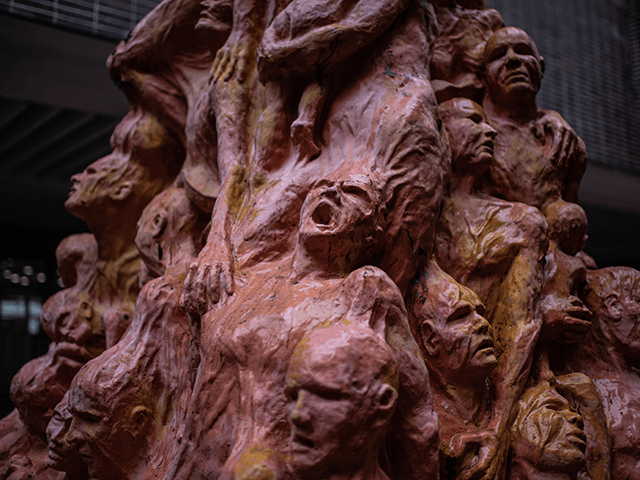Chinese officials tore down the “Pillar of Shame,” a 26-foot-tall statue of brutalized bodies commemorating the 1989 massacre of Tiananmen Square protesters by the Chinese Communist government, on Thursday over the objections of its creator.
The statue has been on display for over 20 years, first at Hong Kong’s Victoria Park and later at the University of Hong Kong.
The brutal Chinese government has been attempting to erase the Tiananmen Square massacre from history ever since it occurred. Discussion of the event is forbidden everywhere in China except Hong Kong and Macau, which were foreign colonial possessions handed over to China in exchange for promises to respect their autonomy and superior civil rights.
Beijing is ruthlessly breaking those promises of autonomy, especially in Hong Kong, where a flourishing pro-democracy movement was crushed with a totalitarian “national security law” in 2020.
Before the national security law was imposed on Hong Kong in a flagrant violation of China’s autonomy agreement with the United Kingdom, Hong Kong hosted the largest commemorations of the Tiananmen massacre on Chinese soil, including a massive annual candlelight vigil in Victoria Park.
Under the new “security” regime, Beijing-controlled Hong Kong officials spent the past two years methodically eradicating Tiananmen commemorations. The group that sponsored the annual candlelight vigil disbanded under intense pressure in September 2021. The vigil itself was banned, originally using the Wuhan coronavirus pandemic as an excuse. Veteran activists who defied the ban to observe the Tiananmen anniversary were arrested. The Communists even banned Tiananmen candle emojis and a “Simpsons” episode that referred to the massacre.
Human rights advocates grimly acknowledged it was only a matter of time before the purge reached the Pillar of Shame, a striking and hellish sculpture of fifty mangled corpses intended to preserve the memory of the hundreds murdered in 1989. On Thursday that day arrived, as the statue was dismantled in the dead of night and unceremoniously tossed into a storage container:
The Pillar of Shame was left in an outdoor area at the #HKU Kadoorie Agricultural Research Centre – Shek Kong Centre (Source RTHK) pic.twitter.com/IDuRNs43b3
— Studio Incendo (@studioincendo) December 23, 2021
“Workers barricaded the monument at the University of Hong Kong (HKU) late on Wednesday night. Drilling sounds and loud clanging could be heard coming from the boarded-up site, which was patrolled by guards,” Al Jazeera News reported.
HKU administrators said the decision to tear down the venerable statue was “based on external legal advice and risk assessment for the best interests of the University,” a fairly blunt admission that they feared persecution under the national security law.
The creator of the statue, Danish sculptor Jens Galschiot, said he was not made aware the work was being removed until he saw it reported on social media Wednesday evening.
The Pillar of Shame is getting demolished right now in Hongkong. The sculpture has been covered and is heavyly guarded so that no students can document what is going on. This is happening in the middle of the night in Hongkong. Im shoked. #Thepillarofshame😢 pic.twitter.com/eSDjTWql7y
— Jens Galschiøt (@Galschiot) December 22, 2021
“We don’t know exactly what happened, but I fear they destroy it. This is my sculpture, and it is my property,” Galschiot said.
“I’ve asked Hong Kong University to allow me to go and collect it in person, but I received no response. If they destroy my work, I’ll seek compensation and demand the remaining pieces to be returned to Europe,” he told the UK Guardian on Thursday.
“This is not about the national security law. This is my private property. It’s the Hong Kong law that says the authorities cannot destroy private properties like this,” the sculptor said.
“This is a sculpture about dead people and [to] remember the dead people in Beijing in ’89. So when you destroy that in this way then it’s like going to a graveyard and destroying all the gravestones,” Galschiot told the BBC.
Galschiot asked his supporters in Hong Kong to “document everything that happens with the sculpture” and urged HKU to return it to Denmark intact.
The Guardian quoted outraged responses to the removal of the Pillar of Shame from democracy advocates and human rights watchdogs:
Samuel Chu, the president of the Campaign for Hong Kong, said: “Its creation in 1997 was a touchstone for freedom in Hong Kong; its destruction in 2021 would be a tombstone for freedom in Hong Kong.”
Nathan Law, a former Hong Kong pro-democracy lawmaker who fled to Britain last year, said the statue would live on in people’s memories. “The PillarOfShame is removed, while memory lives. We must remember what happened on June 4th, 1989. TiananmenMassacre,” he tweeted.
… Maya Wang, a senior researcher on China at Human Rights Watch, said removing the statue “signifies Beijing’s ever-growing intolerance of dissent in Hong Kong”. She added: “The Chinese government is rewriting history as part of its broader efforts to dismantle a free society, and transform the city into one compliant to the Chinese Communist party.”
Dr. Ian Chong, an associated professor at National University in Singapore, told the BBC the Pillar of Shame was “a reminder of Hong Kong’s freer past,” and said its removal “appears to be a signal that the Hong Kong and Beijing governments will no longer tolerate public displays of remembrance of the events surrounding 4 June.”

COMMENTS
Please let us know if you're having issues with commenting.